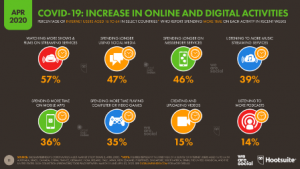Impact of COVID-19 on the Digital Sector
One cannot deny that the current advertising landscape is a definite challenge, but if we look into it with an optimistic point of view, there is also a big opportunity.
Ever wondered what it will be like to live through a pandemic where along with the destruction caused in our lives, most businesses and industries will be at a standstill or even shut down?  Well, here we are. There is no denying that COVID-19 has taken a huge toll on the human race as well as having a drastic impact on several industries, and digital advertising is no exception.
Well, here we are. There is no denying that COVID-19 has taken a huge toll on the human race as well as having a drastic impact on several industries, and digital advertising is no exception.
There is a rule of thumb in the advertising industry, which states that ad spend follows any rise or fall in GDP. Therefore, it is no surprise over the last decades, as global GDP rose 3-6 per cent each year, the ad market has grown with it to around USD 646 billion in 2019. Pre-coronavirus, the ad market was forecasted to grow to USD 865 billion by 2024.
Unfortunately, the pandemic has forced a rethink–Coronavirus, like it affected so many sectors has also led to an immediate drop in advertising spending. First quarter data from Public is showed that year-on-year revenue in China was down 15 per cent. Countries in the Europe saw an average reduction of 9 per cent; Germany and France fell 7 per cent and 12 per cent, respectively. According to WARC, India’s ad growth will ease to +0.7 per cent to USD 9.4 billion in 2020.
One cannot deny that the current advertising landscape is a definite challenge, but if we look into it with an optimistic point of view, there is also a big opportunity. One may also call it a blessing in disguise. As we all know, businesses in many verticals can still experience great results with digital advertising, as long as they make sure that their campaigns are delivering value for those who need to stay at home.
Also Read : Online Education during COVID-19: Dividing the Divided
It is important to notice that wherever consumer behaviour has shifted, advertising spend has adjusted in response. It makes little sense for advertisers to spend on media that have no audience. As confinement measures were introduced around the world, out-of-home and cinema advertising shrank almost instantly; print advertising also fell.
Meanwhile, in-home media usage went up. TV viewership has climbed up to 57 per cent, but digital consumption has increased even more: use of social platforms and streaming services have risen almost 89 per cent; gaming has also grown dramatically.
Advertisers have adapted by following consumers, which means prioritising digital advertising. The online environment is favourable for “direct response” campaigns—those encouraging quick purchases by consumers—an attractive proposition for brands spending cautiously and looking to drive sales. In the first quarter, Facebook and Google saw better than anticipated first quarter revenues.
Before the pandemic, digital advertising was the third largest advertising medium in India. But now, as the directions shift, most of the brands are going 100 per cent exclusively on digital. Digital is projected to grow at 35 per cent vis-à-vis other medium. India’s advertisement market is projected to grow 10.62 per cent y-o-y to Rs 85,250 crore (USD 12.06 billion) till 2021.
 Undoubtedly, COVID-19 has brought change at breakneck speed, and marketers are feeling it. When we leave our houses in the near future, consumerism won’t look the same. Consumers’ priorities have shifted, and marketing strategies should reflect that. Out-of-touch marketing or tone-deaf messaging is one of the fastest ways to alienate the very people we hope to impact.
Undoubtedly, COVID-19 has brought change at breakneck speed, and marketers are feeling it. When we leave our houses in the near future, consumerism won’t look the same. Consumers’ priorities have shifted, and marketing strategies should reflect that. Out-of-touch marketing or tone-deaf messaging is one of the fastest ways to alienate the very people we hope to impact.
Today we can see companies splitting in two groups: either overwhelmed with orders (groceries, household goods, pet supplies, pharmacy, and general merchandise) or lacking orders and interactions (automotive, furniture, luxury, appliances, and hospitality).More than ever shoppers are using a mix of digital touch points along the buying journey. Therefore, digital adoption is the need of the hour, with growing demand in content and increasing production by content creators, the fight for attention is even tougher to hit the recall with the audience you care about.
If you’re not showing up consistently, you will be forgotten very easily and very soon. It is as simple as it gets. Persistent efforts, consistent communication, and frequent reminders are some rules of the game we all have to stick to in order to just be eligible for the play.
Also Read : COVID-19 and Managing Migration: Lessons from Latin America, Africa and Asia
With artificial intelligence (AI) also coming in the picture, it has transformed digital strategies with the ability to collect data, analyse it, apply it and then learn from it. With the technology, marketers can spot micro trends and even predict trends. They can then make strategic decisions about where they allocate their budgets and who they target. As a result, brands can reduce digital advertising waste and ensure that their spend delivers the best possible results.
During previous years, marketers were hesitant to apply AI to their marketing strategies. However, many successful brands have now adopted it and use it within their marketing, with brands like Amazon and Spotify using AI systems successfully.
Thus, it is safe to say that even with an overall slowdown in the global economy, spends are expected to be between low to moderate in H1. This decline in business spends will surely have an impact on the marketing budgets, as we have witnessed many campaigns were stalled and marketing budgets were put on hold. The industries like retail, hospitality, tourism, restaurant, etc. have been most impacted. However, having said that, robust growth is anticipated in H2 2020. With growth rate for TV is estimating to be 7 per cent along with 6 per cent increase in radio. While cinema and Out of Home (OOH) will grow at 15 per cent and 6 per cent, respectively, in 2020 because of obvious reasons.
